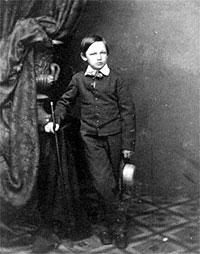 William Wallace Lincoln, “Willie,” died of typhoid fever on February 20, 1862. President Abraham Lincoln and his wife Mary Lincoln were devastated. Willie’s younger brother Tad was also afflicted, but would live. This personal tragedy on top of the ongoing Civil War was almost too much to bear for both of them; Mary would never completely recover. But Willie’s death, and those of 700,000 soldiers during the Civil War, also ushered in advances in the embalming sciences.
William Wallace Lincoln, “Willie,” died of typhoid fever on February 20, 1862. President Abraham Lincoln and his wife Mary Lincoln were devastated. Willie’s younger brother Tad was also afflicted, but would live. This personal tragedy on top of the ongoing Civil War was almost too much to bear for both of them; Mary would never completely recover. But Willie’s death, and those of 700,000 soldiers during the Civil War, also ushered in advances in the embalming sciences.
Called in to care for the body, the Charles D. Brown and Joseph B. Alexander undertaking firm embalmed Willie Lincoln using a new process. Their senior employee, Henry Platt Cattell did the actual embalming, as well as that for President Lincoln three years later.
The process of embalming was relatively new. Generally the blood was drained from the body, although it wasn’t necessary in all cases to do so. In Willie’s (and Abraham’s) case, blood was drained through the jugular vein in the neck, while the embalming fluid was pumped into the body via the femoral artery in the thigh. There were several recipes for the embalming fluid. Zinc chloride was the most common preservative, often made by dissolving strips of zine sheets in hydrochloric acid. The fluid slowed down the degradation process, thus preserving the appearance of the body for a longer period of time.
Because of the ongoing Civil War, Willie Lincoln was interred in Oak Hill Cemetery in the Georgetown neighborhood of Washington, DC. He remained in the Carroll family mausoleum until Lincoln’s assassination, after which Willie’s body accompanied that of the fallen President on the train back to Springfield, Illinois, where both were interred in Oak Ridge Cemetery. Later, all the Lincolns except Robert were laid to rest in the Lincoln Tomb in Oak Ridge Cemetery. Because of his brief Civil War military service and his long service to subsequent presidents, Robert’s tomb is in Arlington National Cemetery across the river from the Lincoln Memorial.
Interestingly, the Carroll family mausoleum, long forgotten as the temporary location of Willie’s body, has one again become a tourist destination following the 2017 publication of Lincoln in the Bardo, a novel by George Saunders. The book takes place in the Oak Hill Cemetery, where Lincoln visits the site of his son’s tomb. The “bardo” is an intermediate space between life and rebirth; the book features conversations with various specters dealing with their sudden deaths, all watching Lincoln’s overwhelming grief.
Prior to the Civil War, those who died were buried quickly to avoid the nastiness of decomposing bodies. Because of advances made in the art and science of embalming during the Civil War and after, led by the work of Dr. Thomas Holmes, it became standard practice to preserve the dead so that they may make the long trips home for proper burial by their families. When Lincoln himself was embalmed, Dr. Brown remained with the funeral train through its winding route from Washington to Springfield, making necessary touchups along the way to preserve Lincoln as much as possible for the grieving populace. To many, we still grieve today, asking ourselves and those around us – What would Lincoln do?
David J. Kent is an avid science traveler and the author of Lincoln: The Man Who Saved America, in Barnes and Noble stores now. His previous books include Tesla: The Wizard of Electricity and Edison: The Inventor of the Modern World and two e-books: Nikola Tesla: Renewable Energy Ahead of Its Time and Abraham Lincoln and Nikola Tesla: Connected by Fate.
Check out my Goodreads author page. While you’re at it, “Like” my Facebook author page for more updates!










